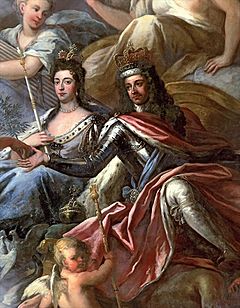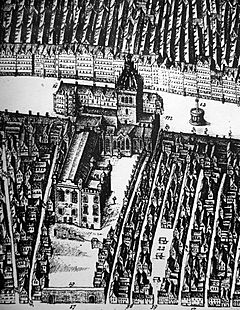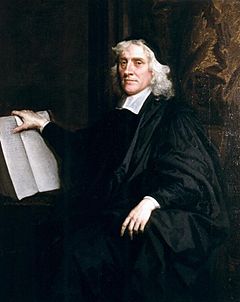Glorious Revolution in Scotland facts for kids
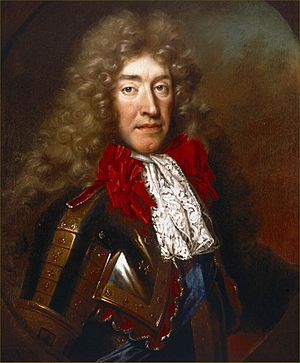
The Glorious Revolution in Scotland was the Scottish part of a big change that happened in 1688. During this time, James VII (also known as James II of England) was replaced as king. His daughter, Mary II, and her husband, William II, became the new joint monarchs of both Scotland and England.
Before 1707, Scotland and England had the same king or queen but were separate countries with their own laws. So, what happened in one country didn't automatically apply to the other. In both nations, this Revolution made sure that the Parliament had more power than the King. Also, the Church of Scotland became Presbyterian again, instead of being led by bishops (Episcopalian).
James became king in February 1685 and had a lot of support. However, people were okay with him being Catholic, but not with Catholicism becoming the main religion. When the Parliaments in England and Scotland refused to remove laws against Catholics, James tried to rule without them.
In June 1688, James had a son who was also Catholic. This worried many people and caused problems in both Scotland and England. A group of English politicians and soldiers invited William of Orange to come to England. They wanted him to support Mary's right to the throne. On November 5, 1688, William arrived in England, and James fled to France on December 23.
Even though Scotland wasn't directly involved in inviting William, many Scottish soldiers were part of William's army. Many of William's advisors were Scottish Protestants who had been living in exile. On January 7, 1689, the Scottish Privy Council asked William to take charge until a special meeting (the Convention) could decide what to do. In February 1689, William and Mary became joint monarchs of England. In March, the Scottish Convention met to make a similar decision for Scotland.
The Revolution was quick and mostly peaceful in England. But in Scotland, some people who supported James (called Jacobites) started a fight. This caused many deaths. Jacobitism remained a political force in Scotland for a long time. In 2016, a law from this time, the Claim of Right Act 1689, was even used in discussions about Brexit.
Contents
Why the Revolution Happened
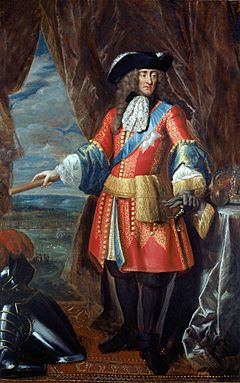
The Glorious Revolution happened differently in Scotland and England. This was because the two countries had different political and religious ideas. They had also experienced the Wars of the Three Kingdoms (1638-1651) and the return of the monarchy in 1660 in different ways. Religion and politics were closely linked, so disagreements caused a lot of trouble.
In the 17th century, "Episcopalian" meant the church was run by bishops, who were chosen by the king. "Presbyterian" meant the church was run by Elders, chosen by the church members. Both groups in Scotland believed in Calvinism. Bishops were also members of the Scottish Parliament. So, arguments about bishops were about politics as much as religion. When the government changed in 1638, 1651, and 1661, the winners often removed their opponents. This made the fight to control the church very bitter.
King Charles II had no legal children. So, his brother James was next in line for the thrones of Scotland and England. In 1669, James secretly became Catholic. When this became known in 1679, the English Parliament tried to stop him from becoming king.
In some parts of Scotland, especially the southwest, James faced a difficult situation. There had been harsh government actions against Protestants under King Charles. Even though a Protestant uprising against James was easily stopped, he had more support in other parts of Scotland. The 1681 Scottish Succession Act said he would be the legal heir "regardless of religion." This Act also said that trying to stop him from being king of England would lead to a "civil war." The 1681 Scottish Test Act confirmed this, but it added that all government officials must "uphold the true Protestant religion." People were okay with James's personal beliefs, but not with Catholicism becoming widespread. James didn't understand this difference, which eventually led to him losing his throne.
James VII Loses His Throne
In 1685, James was more secure in Scotland than in England. The 1681 Scottish laws made it a legal duty to obey the king, "regardless of religion." But in return, these laws confirmed that the Church of Scotland was most important. An uprising against James failed because it didn't have much support. However, James tried to remove the Test Act, which upset his Episcopalian supporters and seemed to reward the Presbyterians who had rebelled.
People felt that James was breaking his promises and ignoring his own supporters. His actions were also badly timed. In October 1685, France stopped allowing Protestants to practice their religion. This caused hundreds of thousands of French Protestants to flee France. The killing of over 2,000 Swiss Protestants in 1686 made people fear that Catholic countries, led by France, were a threat to Protestant Europe.
In June 1688, two events turned the disagreements into a big crisis. First, James had a son on June 10, who was Catholic. This meant a Catholic heir would come before James's Protestant daughter, Mary, who was married to William of Orange. Second, James put seven bishops on trial. This seemed like an attack on the church establishment. When the bishops were found not guilty on June 30, James lost almost all his political power.
In 1685, many people feared a civil war if James was removed. But by 1688, anti-Catholic riots made it seem that only removing him could prevent a war. As things quickly got worse in England, James's main advisor secretly worked with others to invite William to intervene. They promised William support from English politicians for military action. William wanted English money and military help against France. He landed in England on November 5 with 14,000 men. As he moved forward, many of the King's army soldiers left. James went into exile on December 23.
Scotland had been fairly quiet during these events. But once the king fled to France, angry crowds in Edinburgh removed Catholic priests from the Chapel Royal. Events in England happened first. The English Parliament offered their throne to William and Mary in February 1689. James remained King of Scots for four more months, until April 4, 1689. In England, most people agreed that Mary should replace her father. But William insisted he be joint monarch and sole ruler if she died. This was only just approved. In Scotland, the church was divided, which made William more important. Because he was a Calvinist, Presbyterians saw him as an ally. The Episcopalian minority needed his support to keep their power.
The Convention of Estates
On January 7, 1689, the Scottish Privy Council asked William to take over the government. They wanted him to do this until a Scottish Convention could meet and decide on a new government. Out of 125 delegates chosen in March, 70 were Presbyterian. Only a very small number were loyal to James. This meant the Convention was a fight between Episcopalians and Presbyterians over who would control the church and how much power the King would have.
On March 12, James landed in Ireland. On March 16, a letter from him was read to the Convention. He demanded obedience and threatened punishment if they didn't obey. Public anger meant some Episcopalians stopped attending the Convention, saying they feared for their safety. Others changed sides. Tensions were high. The Duke of Gordon held Edinburgh Castle for James. Viscount Dundee was gathering Highland soldiers. This made the Presbyterian majority in the Convention even stronger. The Convention met in secret, guarded by its own troops.
The Scottish Convention met to read letters from James and William on March 16, 1689. On April 4, they voted to remove James VII from office. They used the idea that the king's power came from an agreement with the people.
Later that month, the Convention adopted the Claim of Right and the Article of Grievances. These documents listed what they believed were the rules of Scottish law. They also declared that James had lost his right to the Scottish throne because of his actions against these laws.
The English Parliament said James had "abandoned" his throne the previous December, making the position open. But in Scotland, on April 4, 1689, the Convention declared that James VII "had acted irregularly" by taking power "without ever taking the Coronation Oath required by Law." So, he had "forfeited the Right to the Crown, and the Throne is become vacant." This was a big difference. If Parliament could decide James had lost his throne by actions that "Invaded the fundamentall Constitution of the Kingdome," it meant kings got their power from Parliament, not from God. This ended the idea of the divine right of kings.
To try and keep the Episcopalian church, the Scottish Bishops suggested uniting with England. But the English Parliament said no. On April 11, the Convention ended James's reign. They adopted the Articles of Grievances and the Claim of Right Act. These laws made Parliament the main law-making power in Scotland.
On May 11, 1689, William and Mary accepted the Scottish throne. The Convention then became a full Parliament on June 5. Dundee's uprising showed that William needed Presbyterian support. So, he stopped trying to keep the bishops in power. This led to the 1690 Act of Settlement, which brought back Presbyterianism. The Glorious Revolution in Scotland gave more independence to Parliament and the church. But ending the Episcopalian church upset a large part of the political class. This would be a big factor in discussions about the 1707 Act of Union and the Scottish Jacobite movement.
Parliament's New Power

Important people in the new government included Lord Melville and the Earl of Stair. Melville had joined William in the Netherlands in 1683. Stair had been part of James VII's government. In 1689, Melville became Secretary of State for Scotland, and Stair became Lord Advocate. This was meant to reduce the power of Presbyterians in Parliament.
The first Parliament session was stuck. They couldn't agree on removing bishops from the church or on the Committee of the Articles. This committee was an unelected group that decided which laws Parliament could discuss. Because of this, Parliament refused to approve taxes or appoint legal officers, which basically stopped the law courts. William also blocked laws by not giving his Royal approval to Acts passed by Parliament.
Most Members of Parliament (MPs) formed a group against the government called "the Club." It was led by Sir James Montgomery. He had been one of William's main supporters but was angry that Melville got the Secretary of State job instead of him. Some, like Montgomery, were just upset they weren't in power. But most opposed the government for political reasons. They mainly wanted to get rid of the Committee of the Articles. The government agreed to remove bishops from the church. But they resisted getting rid of the Committee of the Articles. Parliament was then stopped on August 2, after the Battle of Killiecrankie.
Parliament met again in April 1690. There was a lot of tension because of the Jacobite war in Ireland. People feared an Irish invasion of Scotland and continued unrest in the Highlands. A supposed Jacobite plot, called the Montgomery Plot, was discovered. It involved Montgomery and others. In the panic, Melville agreed to get rid of the Committee of the Articles. It's still not clear how serious the plot really was. Once its main goal was achieved, the Club broke apart. On June 7, Parliament approved a law ending the Episcopalian church and granted taxes.
The new constitutional rules that came from the 1689 and 1690 Parliament sessions were less extreme than those in 1641. The King still had important powers, like being able to call, pause, or end Parliament. But in return, getting rid of the Committee of Articles gave Parliament control over what laws were discussed.
Changes to the Church
Fights between different groups in the church had caused deep divisions. This also made it normal to remove opponents who lost. The church's General Assembly met in November 1690. It was the first time since 1654. Even before it met, over 200 ministers who followed the old ways had been removed from their jobs.
This meant the Assembly was mostly made up of radical Presbyterians. They didn't want any part of the Episcopalian system or to bring back those who had been removed. William was also a Calvinist, but he was more tolerant of Episcopalians. He saw them as possible allies and knew it was dangerous to upset an important political group. However, the Assembly removed the Episcopalian system. They created two groups to remove almost two-thirds of all ministers over the next 25 years. The General Assembly of 1692 refused to bring back even those Episcopalian ministers who promised to accept Presbyterianism. This left many church areas with few or no local clergy.
William issued two acts of kindness in 1693 and 1695. These acts allowed ministers who accepted him as king to return. Nearly a hundred clergy took advantage of this. Another act of kindness in 1707 left only a small number of Jacobite Episcopalians and some very strict Presbyterians. The final church settlement was closer to how things were in 1592, rather than the more extreme ideas of 1649. The amount of independence between the church and the state remained unclear. Even though the system of local landowners choosing ministers was officially ended, landowners and elders still kept the right to suggest candidates for their own churches.
Jacobite Resistance
The Scottish Parliament was mostly made up of Presbyterians. There was a small group of people loyal to James, called Jacobites. This group included Roman Catholics, conservative Episcopalians, or those with personal ties to James, like Viscount Dundee, his military leader in Scotland. Most people were not very enthusiastic about either James or William. The Jacobites themselves were also split between Protestant and Roman Catholic groups.
Dundee led a campaign in Scotland to support James, who had landed in Ireland. Often, rivalries between clans or simply wanting to gain something were more important than loyalty to William or James. For example, the Presbyterian Macleans joined the Jacobites to get back land they had lost to the Campbells. The Jacobite Keppoch MacDonalds tried to attack Inverness and were only stopped after Dundee stepped in. Even though the Jacobites won at Killiecrankie in July, they suffered heavy losses, including Dundee himself. Organized resistance ended with defeat at Battle of Cromdale on May 1, 1690. However, it took another two years to make everyone loyal to the new government.
What It Meant for Scotland
The Glorious Revolution made the Presbyterians dominant in the Church of Scotland and the Whigs dominant in politics. But it upset a large part of the political class. The Whigs continued to be powerful in both Scotland and England until the mid-1700s.
Like in England, the Revolution confirmed that Parliament had more power than the King. But by removing bishops from the church, it upset a significant part of the political class. In the long run, being Episcopalian (rather than whether someone was from the Highlands or Lowlands) was a key reason for supporting the Jacobites in both the 1715 and 1745 uprisings. Scotland's involvement in the Nine Years' War and the War of the Spanish Succession eventually led to the Acts of Union. These Acts created Great Britain. The danger of Scotland and England having different kings made a lasting solution necessary.
|
Sources
- Cullen, K. J., Famine in Scotland: The "Ill Years" of the 1690s (Edinburgh University Press, 2010), ISBN: 0748638873.
- Langford, P., The Eighteenth Century, 1688–1815 (Oxford: Oxford University Press, 1976).


